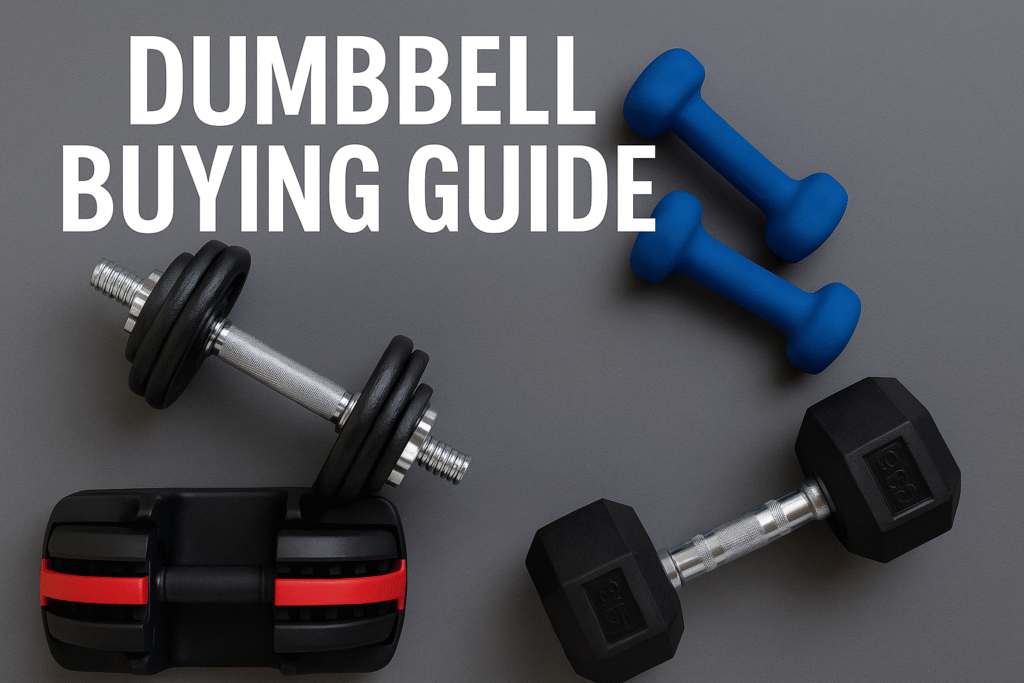Dumbbell buying guide: Dumbbells are one of my all-time favorite pieces of equipment – they’re versatile, effective, and perfect for home gyms. In fact, as Healthline notes, free weights like dumbbells engage more muscles and promote functional fitness. Whether you’re a beginner lifting 5kg for the first time, an intermediate trainee, a senior staying fit, or just building a home gym, choosing the right dumbbells can feel overwhelming.
With so many types (fixed, adjustable, plate-loaded) and materials (rubber, urethane, steel, neoprene, etc.), I get a lot of questions about which dumbbells to pick. This ultimate dumbbell buying guide will walk you through the types of dumbbells, how to choose based on your goals, and even my top picks in each category. Think of this as your one-stop dumbbell reference – I’ve researched expert reviews, gear sites, and manufacturer specs to bring you the most accurate, up-to-date advice as of 2025. Let’s dive in!
The Ultimate Dumbbell Buying Guide
Types of Dumbbells
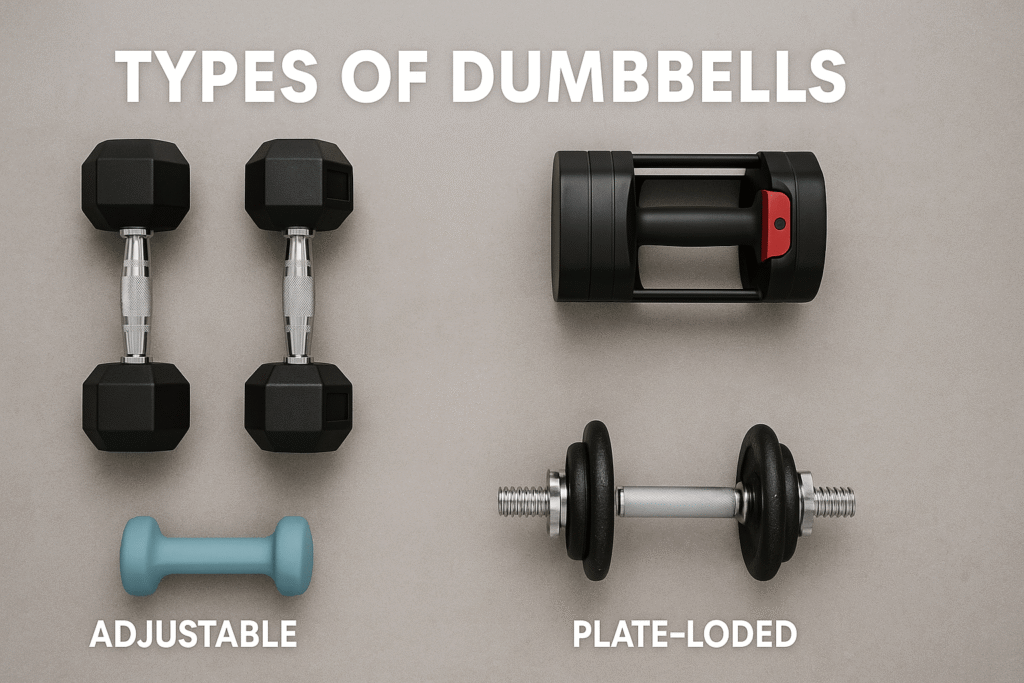
Dumbbells come in several basic styles, each with pros and cons. The main categories are fixed dumbbells, adjustable dumbbells, loadable (spin-lock) dumbbells, and various specialty dumbbells (hex vs round, rubber vs steel, etc.). Here’s what you need to know about each in my dumbbell buying guide. :
Fixed Dumbbells (Standard Free Weights)
These are the classic one-piece weights (often hex- or round-shaped) that you think of when you say “dumbbell.” Each dumbbell has a set weight and handle.
Pros
Fixed dumbbells are very durable and ready to grab – there’s no adjustment time between exercises. High-quality fixed sets can last for decades. They’re great for fast-paced supersets or partner workouts because there’s no fidgeting to change weights. Many fixed dumbbells have protective rubber coating on the heads, which makes them quieter and less likely to damage floors when dropped.
Cons
The biggest drawback is cost and space. Buying an entire set of fixed weights can be expensive, and each additional pair takes up more room. If you buy heavy weights, you’ll likely need a rack (another expense) and significant floor space. Quality fixed dumbbells also tend to be pricier per pound than adjustable alternatives. As one review notes, a luxury fixed set “can run into the thousands of dollars,” whereas a premium adjustable pair is often only a few hundred.
Adjustable Dumbbells (Selectorized or Dial Weights)
These are single handles where you can quickly change the weight via a dial, pin, or selector mechanism. Think Bowflex SelectTech, PowerBlock, or similar brands. Learn more in my Best Adjustable Dumbbells 2025 Buying Guide.
Pros
The huge advantage is space and cost savings. One adjustable set can replace multiple fixed pairs. You literally get many weight increments in the footprint of a single dumbbell. This makes them ideal for home gyms with limited room, as you only need the same space as one dumbbell pair. Adjustables also often have a low cost per pound – for example, you might spend $300 on a 50-lb pair that covers the weight of 10+ fixed dumbbells. They’re convenient to travel with or move around, and they’re generally easy to use once you get the hang of the mechanism.
Cons
Many adjustable models have a lower weight ceiling than heavy fixed pairs; some top out around 50–90 lbs per dumbbell, which can limit advanced lifters. They also typically take a moment to adjust between sets – turning a dial or re-inserting a pin can slow down workouts. Selectorized designs may rattle slightly, and they generally shouldn’t be dropped – fixed dumbbells handle drops better. In short, adjustables are brilliant for most home users, but if you need extremely heavy loads or want instant transitions between weights, fixed or plate-loaded might suit you better.
Loadable (Plate-Loaded/Spin-Lock) Dumbbells
These are mini-barbell-like handles where you add weight plates and secure them with collars. They’re an older style but still common. For detailed options, see my Best Loadable Dumbbells.
Pros
The biggest upside is price. Plate-loaded dumbbells can be very cheap, especially if you reuse plates from a barbell or buy a budget set. They also technically offer unlimited maximum weight – you can keep adding plates as long as the handle can take it. If you’re really on a tight budget or already have barbell plates, this is a space-saver (only the bar + plates instead of many fixed dumbbells).
Cons
It’s a hassle. Every time you change exercises, you have to unscrew collars and swap plates, which interrupts your flow. It’s also easy to fumble or leave plates lying around – not great for a sleek home gym. Most reviewers (even gym owners) admit these are inefficient for regular workouts, since you “don’t want pieces and parts laying around”. In short, plate-loaded dumbbells are only really worth it for ultra-budget setups or using existing plates; otherwise, most people move to fully adjustable dumbbells for convenience.
Specialty Dumbbells (Materials & Shape)
Beyond the basic categories above, dumbbells vary in material (steel, cast iron, chrome, rubber, urethane, neoprene, silicone, etc.) and shape (round vs hex). For a deep dive, check out my Guide to Urethane Dumbbells 2025.
Hex vs Round
Hexagonal dumbbells sit flat on the floor and won’t roll away, which can be handy if you do floor exercises or set them down without a rack. Round dumbbells look cleaner, but will roll.
Materials
Cheap dumbbells might be bare steel or coated in cheap rubber; mid-range ones often use higher-grade rubber or vinyl on the ends; premium sets use urethane (polyurethane) coating or stainless steel. Rubber-coated (or vinyl) heads are softer on drops and absorb noise, but may emit a faint smell over time. Urethane is even more durable and odorless – the highest-end gym dumbbells use it, though urethane dumbbells are very expensive.
There are also neoprene- or silicone-coated dumbbells (usually in light weights with colorful smooth grips) which provide a grippy, slip-resistant feel. For those concerned about toxins, bare steel or silicone-coated dumbbells are non-toxic choices – they don’t off-gas chemicals or odors. In fact, one healthy-home resource calls bare steel the safest option for chemical-sensitive users. Rubber and neoprene can contain phthalates or other additives, so look for “phthalate-free” labels or non-toxic certifications if that matters to you.
If you’re concerned about toxins, explore my Best Non-Toxic Dumbbells guide.
Summarizing the Types of Dumbbells on the Dumbbell Buying Guide
- Fixed (traditional) – durable, instant use, high cost & space.
- Adjustable (dial/pin) – compact, versatile, moderate cost, but limited top weight and slower to switch.
- Loadable (plate) – cheapest per pound, but slow to change and messy.
- Specialty (coated/shape) – covers things like hex vs round or rubber vs steel; pick what suits comfort, noise, and budget (e.g. rubber-coated for quiet home gyms, or stainless/urethane for durability).
How to Choose the Right Dumbbell
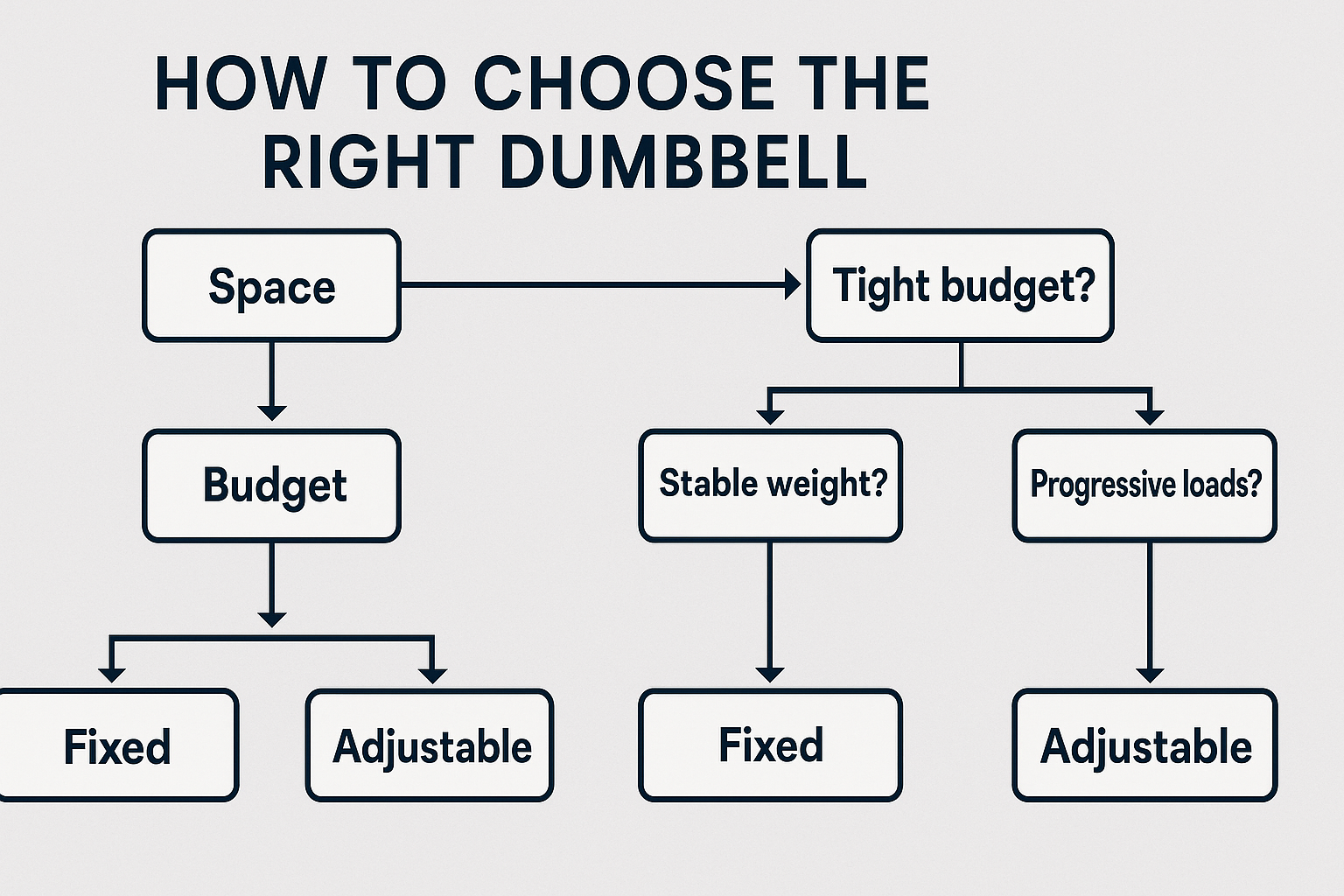
Choosing the best dumbbell depends on your personal needs: your goals, experience, space, and budget. Here are some practical tips I’ve learned and researched to help you decide in my dumbbell buying guide:
Define Your Goals and Needed Weight Range
Are you aiming to build serious muscle, just tone up, or do rehab exercises? If you want to get very strong, you’ll eventually need heavier weights (like 50–90+ lbs per dumbbell). Beginners or seniors often start with light sets (2–10 kg or 5–25 lbs). Even small dumbbells (like 5kg) can build muscle, as long as you use enough reps or progressive tension. For example, a 5kg dumbbell is great for high-rep moves (lateral raises, shoulder presses, etc.) and building endurance.
As Mirafit explains: “There are certainly ways you can utilise 5kg dumbbells in your workout…[to] build muscle and strength”. In short, match the weight increments to your strength: smaller increments for slow progression and isolation work, heavier loads for compound moves. If you don’t know your starting weight, test a few exercises (e.g. dumbbell squat, curl) and see what weight lets you do 8–12 reps with good form. That should guide whether you need a 10kg pair or start at 2–5kg.
Consider Your Space
This is huge for home gyms. If you have room for a rack of dumbbells, a set of fixed weights might be ideal. But if space is tight, adjustable dumbbells are your friend. Check out my Most Durable Adjustable Dumbbells Under $1,000 guide – these sets pack a lot of weight into a small footprint.
As one expert notes, adjustable dumbbells “take up almost no room – the same space as a single pair of fixed-weight dumbbells”. With adjustables, you can slide them under a bench or tuck in a corner when not in use. On the other hand, keeping 5–10 pairs of fixed dumbbells requires a big rack or shelf. So think about your home: an adjustable set (like PowerBlock or Bowflex) might be best for apartments, whereas a garage gym might accommodate lots of fixed plates.
Set Your Budget
Price varies widely: a single fixed dumbbell pair might be $1–$3 per pound (so 50-lb pair = $50–150), whereas a high-end adjustable set might be $500–$800 for 50–90 lbs. Generally, adjustable dumbbells give the most weight per dollar. For example, GymCrafter notes that for the cost of two or three fixed dumbbell pairs you could buy one adjustable set. If you have to choose, fixed dumbbells typically cost more overall.
One drawback: if you want a full fixed set (say 5–50 lbs in 5-lb increments), that might cost thousands. In contrast, a decent adjustable pair gets you multiple increments in one buy. However, high-end adjustables (like selectorized ones) aren’t cheap either. Mid-range options and used markets (eBay or resale) can help if you’re tight on money.
Think About Progression and Versatility
You want gear that grows with you. If you’re a beginner, maybe start with lighter fixed or neoprene sets for confidence and technique. Many lifters later add an adjustable set or a heavier fixed pair. Alternatively, start with a single adjustable handle and add plates (if it’s a spinlock) as you get stronger. If multiple people will use the weights (family members with different strengths), a large adjustable range can accommodate everyone. Also ask: Will you ever want to do supersets (one exercise immediately followed by another)? If yes, fixed weights win, since you can grab two different weights instantly. Adjustables require fiddling between sets, which can slow you down.
Material and Handling Preferences
Some people love the feel of certain handles or coatings. Rubber-encased dumbbells offer a quieter, cushioned drop. Urethane-coated handles (chrome grips with smooth heads) look premium and odorless, but cost more. If you plan to use dumbbells outside or worry about rubber staining, consider bare chrome or stainless options. And if you have allergies or sensitivities, choose “non-toxic” labels – steel or silicone options are safest. Also remember shape: I prefer hex heads for at-home use because they stay put (no rolling).
Fitness Level and Age Considerations
For seniors or true beginners, dumbbells from 1 to 10 lbs (0.5 to 5 kg) are usually most appropriate. Lighter neoprene or vinyl-coated sets (often colorful) are great for senior fitness classes because they’re easy to grip. For advanced intermediate lifters, heavier fixed or plate-loaded handles (50+ lbs per side) might be needed. Always start lighter and scale up – it’s safer to be underwhelmed by a dumbbell weight than to strain on day one.
In Short
Start with what you need now and will reasonably need in the near future. If you have room and funds for a full fixed set (5lb, 10lb, 15lb… up to your limit), go for it. If space or budget is tight, grab a quality adjustable set. If you only want general toning, a 2–15 lb fixed or neoprene set might suffice. Match the dumbbell style to your workout habits: drop-friendly rubber hexes for hardcore lifting, soft neoprene for light circuits, or high-end steel for durability.
Top Dumbbell Picks for Dumbbell Buying Guide
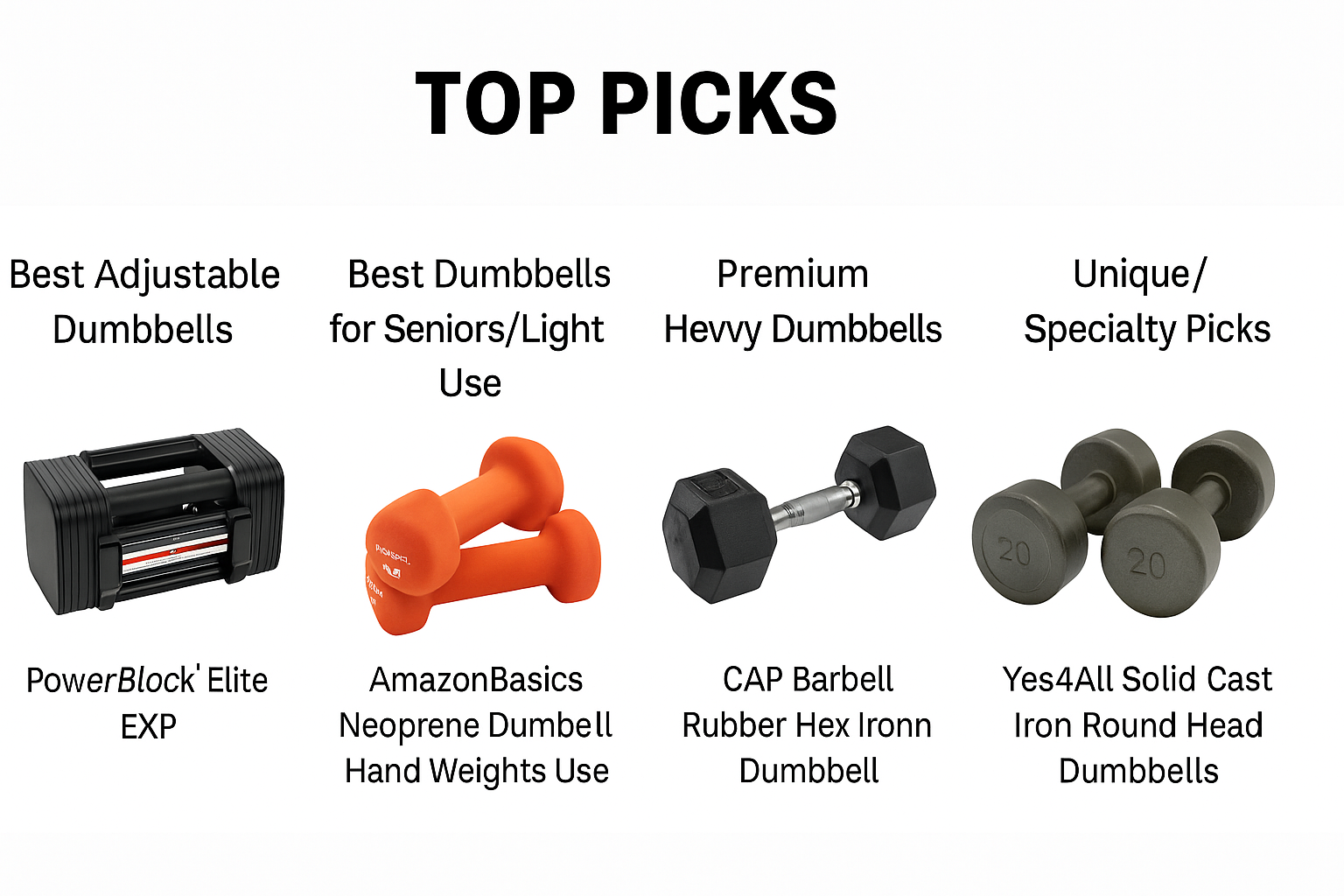
Based on the categories above, here are some standout products that I personally recommend for different needs in the ultimate dumbbell buying guide. These picks come from expert reviews and my own extensive research:
Best Adjustable Dumbbells
PowerBlock Elite EXP 50-70-90 (expansion kits take you from 50 up to 90 lbs per hand). PowerBlocks pack an incredible amount of weight into a compact footprint, and their steel-block selector mechanism is rock solid for fast changes and heavy lifts. If you’re looking for a more budget-friendly but still smooth-adjusting option, check out the Ativafit Adjustable Dumbbells (11–66 lbs)—they use a quick-lock pin system and come as a pair with a handy stand. Both sets give you all the versatility of multiple fixed weights without the clutter or cost of dozens of individual dumbbells.
Best for Space & Value
NordicTrack Select-a-Weight Dumbbells (10–55 lb per dumbbell, 15 increments). These handle up to 55 lbs each in one compact set. They’re a great compromise between cost and function. Also, Ativafit Adjustable Dumbbells (11–66 lb each) – reviewers love their quick-adjust mechanism and solid feel. You can read more in my Best Adjustable Dumbbells 2025 Buying Guide.
Best Budget Dumbbells
For very tight budgets, simple options like Yes4All Adjustable Dumbbell Set (includes handle + plates, 40–200 lbs options) or CAP Barbell Spinlock Dumbbells offer low cost. If you just want light weights, AmazonBasics Dumbbell Set (A set of 2 dumbbells (38 pounds total weight): TWO 3-pound dumbbell handles, FOUR 2.5-pound plates, FOUR 5-pound plates, and FOUR 0.5-pound collars) are cheap, and good for beginners or seniors.
Best Dumbbells for Seniors or Light Use
AmazonBasics Neoprene Dumbbell Hand Weights (pairs from 2–10 lb). These neoprene-coated dumbbells have a comfortable, slip-resistant grip and come in easy-to-see colors—perfect for beginners or seniors focusing on light resistance training. They’re widely available on Amazon USA and often sold in bundled pairs with a handy stand. Another solid option is the BalanceFrom Hex Neoprene Dumbbells (1–10 lb), which offer the same grippy feel and flat sides to prevent rolling. You can read and see more details in my Best Adjustable Dumbbells for Seniors.
Premium Heavy Dumbbells
CAP Barbell Rubber Hex Dumbbells (150 lb Dumbbell Set with racks). These high-quality rubber hex dumbbells feature ergonomic handles and solid construction—ideal for serious lifters who want durability and minimal noise. CAP Barbell’s hex dumbbells are widely praised for their consistent dimensions, comfortable knurling, and the fact that they won’t roll away during workouts. They’re available on Amazon USA across the full weight range, making it easy to build out a complete set. Another top-tier choice is the AmazonBasics Rubber Encased Hex Dumbbell series (5–50 lb), which offers reliable performance at a slightly lower price point.
Unique/Specialty Picks
Core Home Fitness Adjustable Dumbbells (magnetic selector) have unique designs. PowerBlock Sport is entry-level but very compact. They’re widely available on Amazon USA in a full range of weights and are praised for their consistent shape and solid build. They are ideal for both home and light commercial use.
(Note: Prices and availability are subject to change; please check the current Amazon USA listings before making a purchase from my dumbbell buying guide blog post. The embedded “red” links (above) take you directly to product pages if you want more details.)
Dumbbell Buying Guide Comparison Table
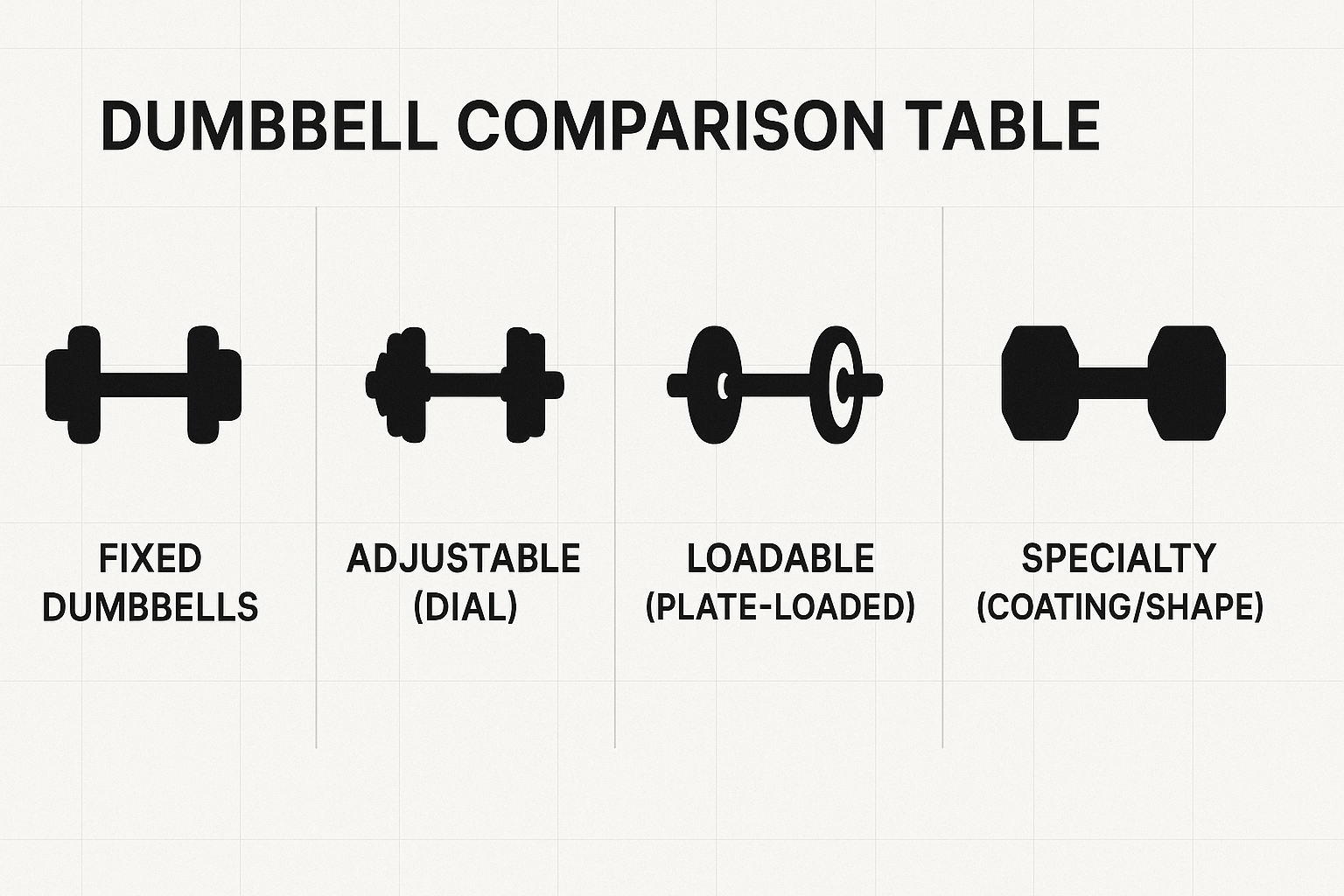
For a quick glance at the dumbbell buying guide, here’s how the main dumbbell types stack up:
| Type | Weight Range | Space/Cost | Pros | Cons |
|---|---|---|---|---|
| Fixed Dumbbells | ~1–125 lbs (each pair) | High: One new pair per weight, plus rack space | Very durable and simple. No wait to change weight (good for supersets). | Can be very expensive overall. Takes up lots of room. |
| Adjustable (dial) | ~5–90 lbs (per dumbbell) | Moderate: One set of handles (or two) | Compact and space-saving. Cost-effective vs. many fixed sets. Very versatile. | Limited max weight. Slower to change weights between sets. Some designs can rattle. |
| Loadable (plates) | 10–200+ lbs (per handle) | Low: Single handle(s), use plates you have | Cheapest per pound (use existing plates). Can add large weight if needed. | Time-consuming to swap plates. Messier/ cluttered. Handle can be thin/uncomfortable. |
| Specialty (Coating/Shape) | Varies | Varies | Hex heads = no-roll. Rubber heads are quiet. Urethane is odorless and very durable. | Some materials (cheap rubber, neoprene) can have chemical odors or wear faster. |
Dumbbell Buying Guide FAQ (Frequently Asked Questions)
What kind of dumbbells should I buy?
It depends on where and how you’ll work out. In my opinion, it all comes down to space and budget. If you have plenty of room and money, a full set of fixed-weight dumbbells (5, 10, 15,…up to your target) is ideal – no adjustment needed, great for intensity. If space or budget is limited, go for a quality adjustable dumbbell set: one pair that covers a range (e.g. 5–50 lbs). Also consider your workout style: people who do fast-paced circuits or train with a partner often prefer fixed weights (no delays switching), while solo home exercisers may love the convenience of adjustables. Ultimately, match the dumbbell type to your workouts, strength level, and available space.
How do I choose the right dumbbell weight?
Pick a weight that lets you maintain good form for your goals. For strength, choose a dumbbell you can lift for about 6–10 reps with effort; for muscle endurance/tone, 12–15 reps is good. Beginners often start light (2–10 kg or 5–20 lbs) and progress from there. I have tried and tested that lighter weights can still build muscle if used correctly (for technique training, accessory movements, or high-rep sets). The rule of thumb: the last few reps in your set should be challenging but doable. If you’re unsure, start smaller – you can always increase weight later.
Fixed vs. Adjustable: Which is better?
There’s no one-size-fits-all answer. Fixed dumbbells offer ultimate simplicity and durability. You just pick the pair and go – perfect for quick supersets or multiple users. However, they eat up space and money. Adjustable dumbbells save huge space (all your weights in one piece) and can save money vs buying many fixed pairs. On the downside, high-quality adjustables can cost as much as 3–4 fixed dumbbells, and you have to twist a dial or change plates to switch weights. If you plan to drop weights or use extremely heavy loads, fixed units (with rubber ends) are safer. If convenience and space-saving are top priorities, adjustables win. Many people end up using both: a pair of adjustable dumbbells for 5–60 lbs and then a heavy fixed pair (like 70–80 lbs) for their max strength moves.
Can 5kg (about 10 lb) dumbbells build muscle?
Absolutely. Lighter dumbbells are not useless – they’re just better for different goals. According to fitness experts, 5kg dumbbells can indeed build muscle when used properly. They’re great for mastering technique on exercises, and they allow you to do high-rep sets or accessory movements (like lateral raises, extensions, curls) where heavier weights aren’t needed. You can also use 5kg weights to improve muscular endurance by doing 15–20+ reps per set. The focus should be on form and time under tension – you can build strength by increasing reps or slowing the tempo. So if 5kg is what you have, use it creatively! Eventually, you’ll graduate to heavier dumbbells for primary lifts, but don’t underestimate a good burn from lighter weights in a well-structured routine.
What’s the difference between rubber, urethane, and neoprene dumbbells?
These terms refer to the head/covering material. Rubber-coated dumbbells (often hex shapes) have a tough rubber shell over the metal. They absorb impact, making them quieter and kinder to floors. Rubber dumbbells are generally affordable. They may develop a mild “gym smell” over time, and recycled rubber can be slightly tacky on the skin. Urethane-coated dumbbells use polyurethane (a very hard plastic) for the ends. Urethane is highly durable – it resists cracks, chips, and fading, and it doesn’t smell or stain. Urethane dumbbells have a clean, glossy look but cost much more (often 2–3× the rubber price for the same weight). Neoprene or vinyl dumbbells are usually lightweight (2–10 lbs) with a colored coating. They feel grippier and are often marketed as “beginner” or “aerobics” dumbbells. Neoprene/Vinyl is softer than rubber and smells slightly like plastic. Lastly, bare steel or chrome dumbbells (no coating) will last forever and never emit any odor. They’re very heavy per size. The choice depends on your budget and preference: go with rubber if you want durability at a moderate price, urethane for top-tier longevity, neoprene for cheap and comfy light weights, and bare metal if you want a no-nonsense feel.
Should I choose round or hex dumbbells?
Hexagonal dumbbells (6-sided) have flat edges so they won’t roll away if you set them down. This can be safer when doing floor exercises or if you have kids/pets around. Round dumbbells (like Olympic chrome style) may look sleeker and fit aesthetic gyms, but they can roll. Functionally, there’s no performance difference aside from that. Most home gyms use hex dumbbells for practicality. Some specialty plate sets use square or extremely long plates to mimic hex stability for exercises like dumbbell push-ups.
What dumbbells are best for seniors or beginners?
Generally, seniors and newbies start with lighter, easy-to-hold weights. I recommend neoprene or vinyl-coated hex dumbbells in the 1–10 lb range. These have thicker, grippy handles and won’t hurt if dropped. Sets like AmazonBasics Neoprene Dumbbells or BalanceFrom Hex Dumbbells come in small increments and often on a small rack. Seniors should focus on form and comfort: a weight that lets them do 10–15 reps without strain. Starting as low as 2.5 or 5 lbs can be beneficial. Some seniors like dumbbells with larger, ergonomic handles (even “pump grips” that fill the palm). The key is progressive training – once 5 or 10 lbs become easy, gradually move up. Adjustable sets tend to be less useful here since seniors often only need light weights.
Do I need a dumbbell rack or stand?
If you go the fixed-weight route, a rack is almost a necessity to keep weights organized and off the floor. Without a rack, clutter builds up quickly. Adjustable sets usually come with a cradle or base, but they can sit on the floor or a bench, too. In any case, storage is important for safety. If floor space is precious, find a corner or wall-mounted solution. Some sets (like Bowflex or NordicTrack) come with matching stands – these help reach higher weights easily and free up floor space. In summary, a rack or stand isn’t required, but it greatly improves organization and makes multi-weight workouts smoother.
Can dumbbells go outside or need special care?
Most dumbbells prefer indoor, dry environments. Rubber and urethane can crack in extreme cold or fade in strong sun. If you work out outdoors, consider stainless or coated steel dumbbells. Always wipe down neoprene or rubber handles after sweaty sessions to prevent skin oils from degrading the coating. For longevity, keep them dry (to avoid rust on bare steel) and occasionally check and tighten adjustable collars. A light spray of silica gel or rust-inhibitor on metal parts can’t hurt if you live in a humid area. But for the most part, dumbbells are low-maintenance – just store them neatly and they’ll last for years.
Why are dumbbells so expensive?
The price comes down to the material and manufacturing. A high-quality steel handle with precision-machined knurling and solid (urethane or heavy rubber) heads costs more to make than a simple metal pipe with used car tires as ends. Specialized weight coatings (like urethane or coated concrete) and brand reputations can also raise cost. When you see a very cheap dumbbell, know that it may have thinner steel or low-grade rubber that will wear out. That said, there are good deals too – shopping sales or certified used sets can save a lot. In practice, it’s an investment: a pair of well-made dumbbells should last decades, so it’s often worth spending a bit more upfront.
(These FAQs cover common dumbbell questions on the dumbbell buying guide, but if yours isn’t here, feel free to leave a comment and I’ll try to help!)
Dumbbell Buying Guide Conclusion: Ready to Lift?
I hope this dumbbell buying guide has answered all your dumbbell questions! Whether you’re after the best adjustable dumbbells for a tiny gym, neoprene weights for gentle workouts, or the toughest rubber hex dumbbells for heavy lifting, you now have the knowledge to choose wisely. For more in-depth picks and reviews, check out my related posts on Best Dumbbells for Home Gym Under $1,000 and Most Durable Adjustable Dumbbells Under $1,000. And of course, don’t forget to pair your new dumbbells with the right bench or rack if you need one. Happy lifting, and stay strong out there!
Affiliate Disclosure: As part of my commitment to transparency, please note that some of the links in this dumbbell buying guide are affiliate links. If you choose to purchase through these links, I may earn a small commission at no extra cost to you. Your support helps me keep creating free, in-depth fitness resources. Thank you for reading!

Mohammad Nazif Uddin is a Marketing and Supply Chain Management student and fitness enthusiast with over 5 years of bodybuilding experience. As the founder of Muscle Theory, he shares practical insights on fitness supplements to help others make informed choices and achieve their goals safely.

